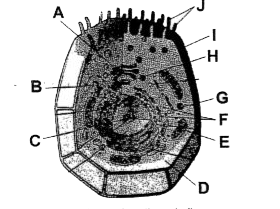The adaptations that reduce the transpiration are
I. cutin
II. Sunken stomata.
III. Increased surface area.
IV. Ethylene.
Only III
I and II
II, III and IV
I and III
The correct Answer is:B
Step by step video, text & image solution for The adaptations that reduce the transpiration are I. cutin II. Sunken stomata. III. Increased surface area. IV. Ethylene. by Biology experts to help you in doubts & scoring excellent marks in Class 12 exams.
Topper's Solved these Questions
- BOOK - ARIHANT NEETCHAPTER - TRANSPORT IN PLANTS EXERCISE - Chapter exercises B. Medical entrances special format questions (Match the columns )3videos
TRANSPORT IN PLANTS
- BOOK - ARIHANT NEETCHAPTER - TRANSPORT IN PLANTS EXERCISE - Chapter exercises B. Medical entrances special format questions (Assertion and reason)10videos
TRANSPORT IN PLANTS
- BOOK - ARIHANT NEETCHAPTER - TRANSPORT IN PLANTS EXERCISE - Chapter exercises A. Taking it together (Assorted Questions of the Chapter for Advanced Level Practice )138videos
TRANSPORT IN PLANTS
- BOOK - ARIHANT NEETCHAPTER - THEORIES OF EVOLUTIONEXERCISE - Chapter exercise C (Medical entrances gallery ( collection of questions Asked in NEET & Various Medical Entrance Exames )4videos
THEORIES OF EVOLUTION
- BOOK - ARIHANT NEETCHAPTER - VIRUSES EXERCISE - C. Medical entrances gallery32videos
VIRUSES
Similar Questions
Assertion:Waxy and cutin coating on plant parts reduce the transpiration.
Reason:These adaption are found in xerophytes.View SolutionCorrelate the given features of animal cells (I to IV) with their respective parts :-

I. The structure replicates during division and organizes the spindle.
II. Main arena for cellular activities
III. Power house of the cell.
IV. Increase the surface area of the absorption of materials.View Solution
Knowledge Check
- Question 1 - Select One
Which of the following are correct for conifers ?
I. Needle - like leaves to reduce surface area.
II. Thick cuticle on leaves.
III. Sunken stomata to reduce water loss.
IV. The main plant body is gametophyte.AII and IIIBOnly IVCOnly IDI, II and III - Question 2 - Select One
Osmosis controls
I. transportation
II. Opening and closing of stomata.
III. PhotosynthesisAI and IIIBI and IICNone of theseDAll of these - Question 3 - Select One
Rate of transpiration is
I. increased with increase in temperature.
II. Stopped in dark, due to elosure of stomata.
III. Decreased, when relative humidity is high.
IV. Decreased with wind velocity.AI, II and IIIBI and IICOnly IIDOnly IV
Read the following statements regarding the ciliated epithelium .
I. Found only in the lining of the trachea .
II cilia are found on the free surface of the cells.
III Help in moving particles or mucus in a particular direction over the epithelium.
IV Microvilli are found at the free end to increase the surface area of the organ.
identify the ones that are correct .View SolutionCatalyst
(i) increases the average kinetic energy of the molecules .
(ii) decreases the activation energy
(iii ) alters the reaction mechanism
(iv ) incerases the surface area of the reactants
which of the following is CORRECT ?View SolutionThe following is (are) endothermic reaction
I. combustion of methane.
II. Decomposition of water.
III. Dehydrogenation of ethane to ethylene
IV. Conversion of graphite to diamondView SolutionThe needle like, reudced surface area, thick cuticle and sunken stomata are the charatceristic feature of the which group of plants :
View SolutionRead the following statements about adaptations in desert plants and select the correct ones.
(i) They have a thick cuticle on their leaf surfaces.
(ii) They have stomate present in deep sunken pits.
(iii) They use CAM pathway for photosynthesis.
(iv) They have flattened stems and large sized leaves.
(v) Their stomata remain closed during the day.View Solution

